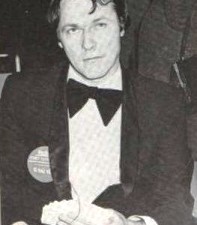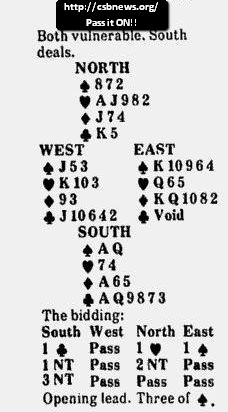
Source: Lakeland Ledger – 17 Oct 1975
Dear Messr’s Goren and Sharif: Some of those plays you describe are way out. I am prepared to bet that they are not found at the table, but that the two of you dream them up.
Sincerely, P .S.B., San Francisco
Certainly, the winning line is not always found at the table and sometimes is only uncovered in postgame analysis. But don’t let that lead you to the conclusion that most of the hands featured in bridge columns are figments of the authors imagination. Bridge experts do make most of the fine plays described as witness this hand from the recent European Championship.
Declarer at 3NT was the young Swedish star Per Olof Sundelin. South rebid of 1NT showed a better than a minimum opening, for there was no need for him to take any action over the overcall unless he had extra values.
Thus, North was correct to invite game with his 9 points and five-cards suit, and South accepted on the basis of his six clubs.
West led the ![]() 3. East played the
3. East played the ![]() K and declarer won the
K and declarer won the ![]() A. He could count two spade tricks and 1 trick in each red suit, so he needed only five tricks in club for his contract. If clubs broke no worse than 4-1 there was no way he could fail to make the necesaary tricks in the suit. But what If the suit divided 5-0?
A. He could count two spade tricks and 1 trick in each red suit, so he needed only five tricks in club for his contract. If clubs broke no worse than 4-1 there was no way he could fail to make the necesaary tricks in the suit. But what If the suit divided 5-0?
If East held all the missing clubs, West would show out when a club was led to the king and a club from dummy would force East to split his honors to prevent declarer from winning the second club with a spot card. Declarer will then force out the remaining honor to establish the suit. The problem therefore was to protect against five clubs in the West hand.
At trick two Sundelin led the ![]() 7. West played low and so did dummy! This was a perfect safety play. If East won the first club, declarer’s
7. West played low and so did dummy! This was a perfect safety play. If East won the first club, declarer’s ![]() A-K-Q in the suit would draw the three outstanding clubs. When East showed out declarer continued with a club to the
A-K-Q in the suit would draw the three outstanding clubs. When East showed out declarer continued with a club to the ![]() K, reentered his hand with the ace of spades and conceeded a club. He was now assured of nine tricks for the defenders could take at most, three spade tricks before declarer regained the lead.
K, reentered his hand with the ace of spades and conceeded a club. He was now assured of nine tricks for the defenders could take at most, three spade tricks before declarer regained the lead.
Here is the original article appeared in the Bulletin Nº9 of the 32nd European Championship, Brighton 1975.
 Almost forty years later P. O. commented about this hand:
Almost forty years later P. O. commented about this hand:
